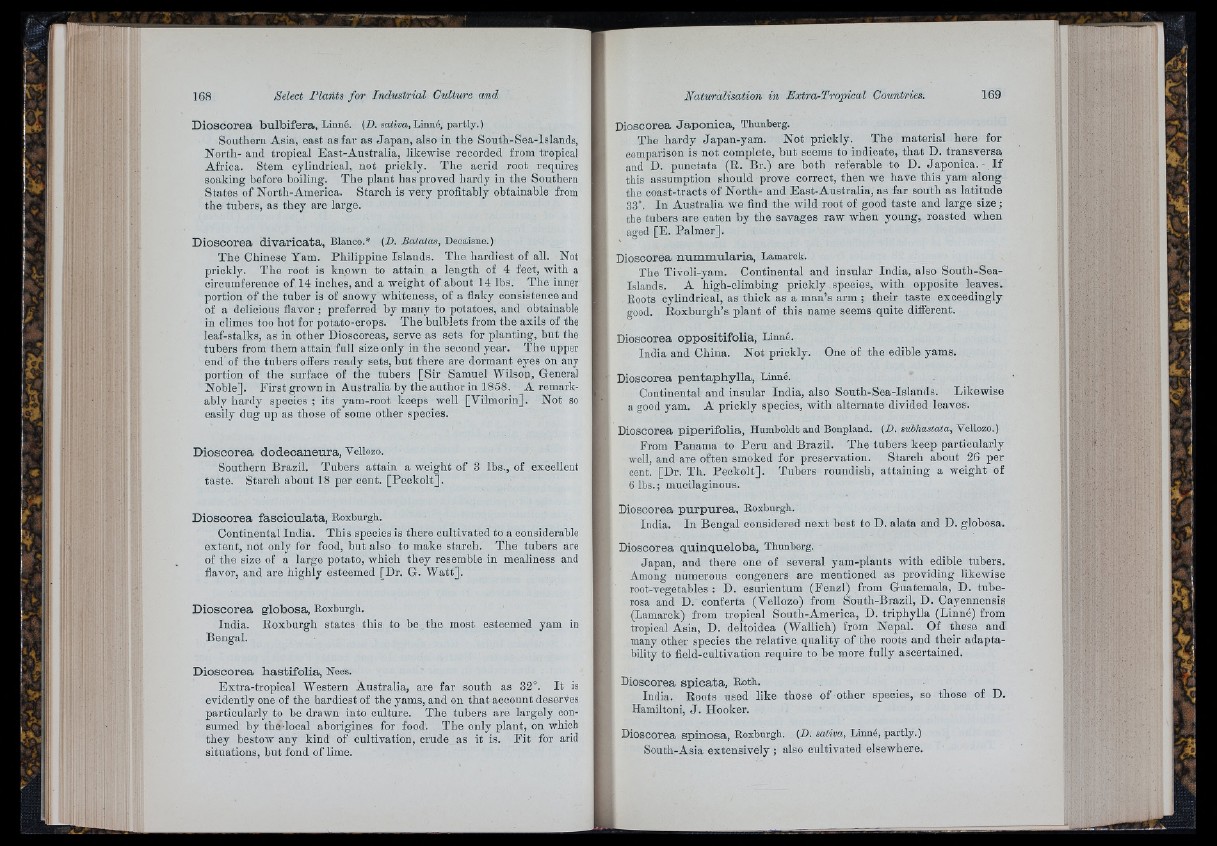
D io s c o re a b u lb if e r a , Linné. (A. soeiim,Linné, partly.)
Southern Asia, east as far as Japan, also in the South-Sea-lslands,
North- and tropical East-Australia, likewise recorded from tropical
Africa. Stem cylindrical, not prickly. The acrid root requires
soaking before boiling. The plant has proved hardy in the Southern
States of North-America. Starch is very profitably obtainable from
the tubers, as they are large.
D io sco re a d iv a r ic a ta , Blanco.* (A. Batatas, Decaisne.)
The Chinese Yam. Philippine Islands. The hardiest of all. Not
prickly. The root is known to attain a length of 4 feet, with a
circumference of 14 inches, and a weight of about 14 lbs. The inner
portion of the tuber is of snowy whiteness, of a flaky consistence and
of a delicious flavor ; preferred by many to potatoes, and obtainable
in climes too hot for potato-crops. The bulbiets from the axils of the
leaf-stalks, as in other Dioscoreas, serve as sets for planting, but the
tubers from them attain full size only in the second year. The upper
end of the tubers offers ready sets, but there are dormant eyes on any
portion of the surface of the tubers [S ir Samuel Wilson, General
Noble]. F irst grown in Australia by the author in 1868. A remarkably
hardy species ; its yam-root keeps well [Vilmorin]. Not so
easily dug up as those of some other species.
D io s c o re a d o d e c a n e u ra , Vellozo.
Southern Brazil. Tubers attain a weight of 3 lbs., of excellent
taste. Starch about 18 per cent. [P e c k o lt].
D io sc o re a fa s c ic u la ta , Roxburgh.
Continental India. This species is there cultivated to a considerable
extent, not only for food, but also to make starch. The tubers are
of the size of a large potato, which they resemble in mealiness and
flavor, and are highly esteemed [Dr. G. Watt].
D io s c o re a g lobosa, Roxburgh.
India. Roxburgh states this to be the most esteemed yam in
Bengal.
D io s c o re a h a s tifo lia , Nees.
Extra-tropical Western Australia, are far south as 32°. I t is
evidently one of the hardiest of the yams, and on that account deserves
particularly to be drawn into culture. The tubers are largely consumed
by the local aborigines for food. The only plant, on which
they bestow any kind of cultivation, crude as it is. F it for arid
situations, but fond of lime.
D io sco re a J a p ó n ic a , Thunberg.
The hardy Japan-yam. Not prickly. The material here for
comparison is not complete, hut seems to indicate, th a t D. transversa
and D. punctata (R. Br.) are both referable to D. Japónica. - I f
this assumption should prove correct, then we have this yam along
the coast-tracts of North- and East-Australia, as far south as latitude
33°. In Australia we find the wild root of good taste and large size;
the tubers are eaten by the savages raw when young, roasted when
aged [E. Palmer].
Dio sco rea n u m m u l a r ia , Lamarck.
The Tivoli-yam. Continental and insular India, also South-Sea-
Islands. A high-climbing prickly species, with opposite leaves.
Roots cylindrical, as thick as a man’s arm ; their taste exceedingly
Roxburgh’s plant of this name seems quite different.
Dio sco rea o p p o s itifo lia , Linné.
India and China. Not prickly. One of the edible yams.
Dio sco rea p e n t a p h y l l a , Linné.
Continental and insular India, also South-Sea-Islands. Likewise
a good yam. A prickly species, with alternate divided leaves.
Dioscorea p ip e rifo lia , Humboldt and Bonpland. (A. suhhastata, Vellozo.)
From Panama to Peru and Brazil. The tubers keep particularly
well, aud are often smoked for preservation. Starch about 26 per
cent. [Dr. Th. Pe ck o lt]. Tubers roundish, attaining a weight of
6 lbs. ; mucilaginous.
Dioscorea p u rp u r e a , Roxburgh.
India. In Bengal considered next best to D. alata and D. globosa.
Dioscorea q u in q u e lo b a , Thunberg.
Japan, and there one of several yam-plauts with edible tubers.
Among numerous congeners are mentioned as providing likewise
root-vegetables : D. esurientum (Fenzi) from Guatemala, D. tuberosa
and D. conferta (Vellozo) from South-Brazil, D. Cayennensis
(Lamarck) from tropical South-America, D. triphylla (Linné) from
tropical Asia, D. deltoidea (Wallich) from Nepal. Of these and
many other species the relative quality of the roots and their adaptability
to field-cultivation require to be more fully ascertained.
Dioscorea s p ic a ta , Roth.
India. Roots used like those of other species, so those of D.
Hamiltoni, J . Hooker.
Dioscorea sp in o s a , Roxburgh. (A. sativa, Linné, partly.)
Soutli-Asia extensively ; also cultivated elsewhere.